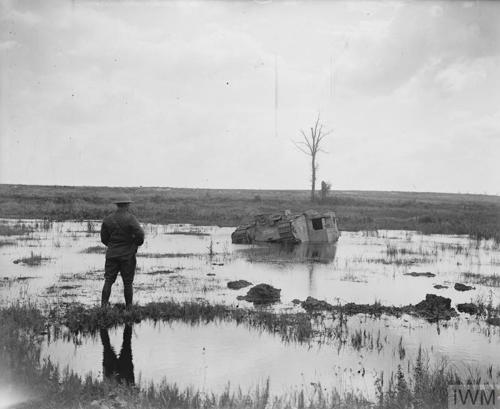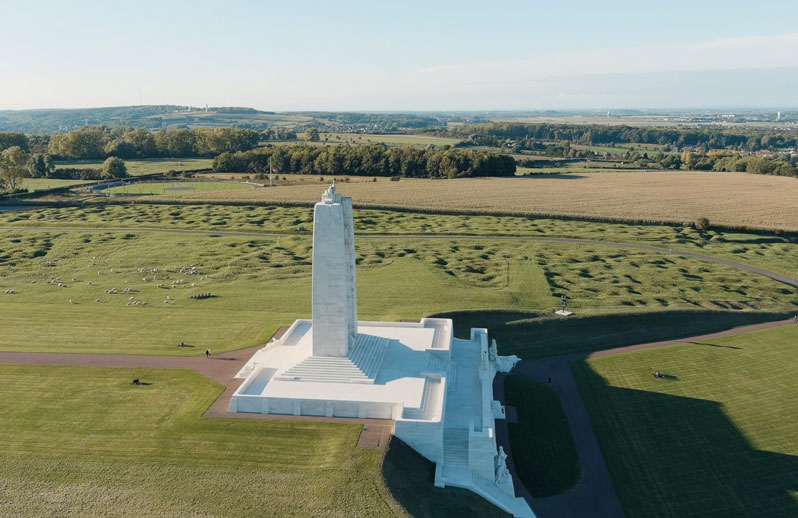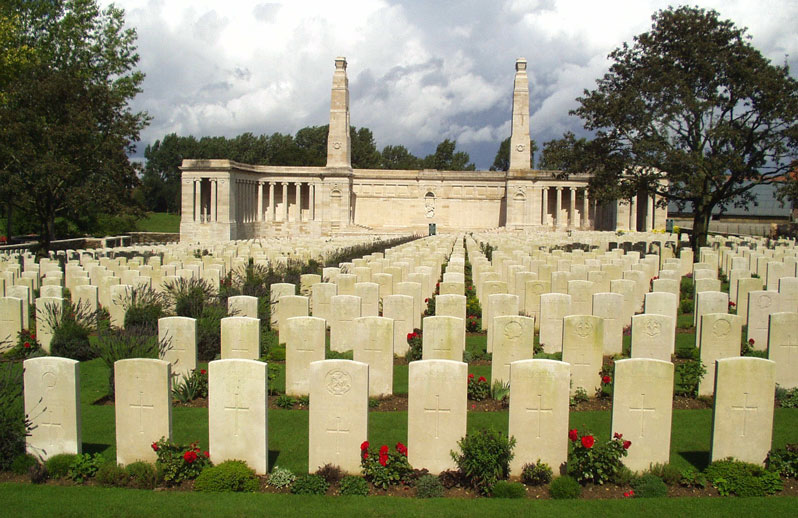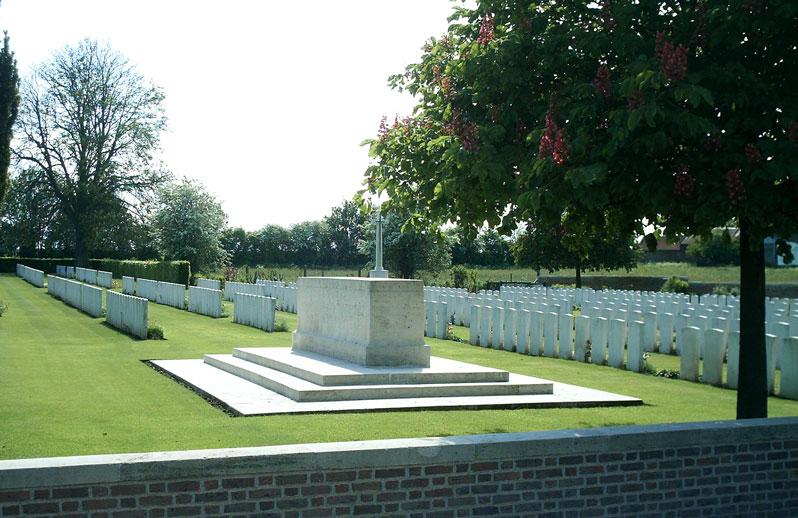16 August 2023
Canada’s Hundred Days: The Canadian Contribution to Great War Victory
Canadian forces played a major role in the First World War-winning Hundred Days Offensive. Discover the story of Canada’s Hundred Days with the Commonwealth War Graves Commission.
Canada’s Hundred Days
The Advance to Victory

Image: Canadian troops advance during the Hundred Days Offensive. The Canadian Corps was deployed in some of the fiercest battles of the campaign at a heavy cost (© IWM Q 9325)
The Hundred Days Offensive was the final major advance undertaken by Allied armies in August 1918.
The period covered 8 August to 11 November when the Armistice was signed and a ceasefire fell across the bloody battlefields of the Western Front.
Across this time, the Allies of the British Empire, France, The United States and Belgium, fought many battles and lost many men. Commonwealth forces were present too with Australian, Indian, New Zealand, South African and of course, Canadian troops present in major numbers.
Despite breaking the Imperial German Army’s ability to fight, the Advance to Victory came at a heavy cost. The Allies took 412,000 casualties across the Hundred Days Offensive.
What was Canada’s Hundred Days?
 Image: A Great War era Canadian recruitment poster (Wikimedia Commons)
Image: A Great War era Canadian recruitment poster (Wikimedia Commons)
Canada’s Hundred Days is the name given to a series of attacks spearheaded by the Canadian Corps during the wider Hundred Days Offensive.
The Canadian Corps, formed of five Canadian divisions, was often at the spearhead of the Allied advance, involved in the thick of the fighting from the campaign’s opening salvoes.
The First World War was a nation-defining experience for Canada. At the Battle of Vimy, the Canadian Corps fought together as a single unit for the first time, winning a stunning victory.
Vimy proved that Canada could stand on its own two feet as a nation, sowing the seeds of its independence to come.
Following Vimy, Canadian servicemen would be at the forefront of some of the toughest battles of the First World War’s closing phases. Such service would come with a heavy cost as we will cover later.
During the Hundred Days Offensive Canada’s four divisions totalled some 100,000 men. They fought under the auspices of British Fourth Army in the campaign’s initial stages before falling under British First Army towards the end of the advance.
These 100,000 or so Canadians engaged, defeated, or forced the retreat of elements of some 47 opposing German Divisions: a quarter of the Imperial German Forces facing the Allies on the Western Front.
Major battles of Canada’s Hundred Days
The Battle of Amiens
Interestingly, the Canadian Corps was so often used as the vanguard of Allied attacks that German High Command had come to expect an attack whenever Canadians showed up in their sector.
At the Battle of Amiens, the opening assault of the Hundred Days Offensive, the Allies used this to their advantage.
A deception operation was devised. Two Canadian infantry battalions, a wireless unit, and a casualty clearing station were sent to Ypres in Flanders, Belgian. This was a bluff to convince the defending Germans an attack would come in Belgium.
Meanwhile, the rest of the Canadian Corps was marched to its starting positions near Amiens.
At 4.20 am on 8 August 1918, under heavy fog, the Battle of Amiens began with an ear-splitting artillery barrage. The German Army was taken completely by surprise. The Ypres deception had worked.
During the attack, the Canadians formed positions to the south of their Australian allies who were attacking in the centre of the Allied lines.
The assault at Amiens was a major success. The Allies punched a hole 15 miles wide in the German lines. On the battle’s first day, the Canadian Corps advanced as far as eight miles in places.

Image: Canadian infantry on the move during the Battle of Amiens, supported by an Armoured Autocar (Wikimedia Commons)
A mixture of surprise and a rapid tank-led advance helped the rapid Allied and Canadian push. German morale was pushed to breaking point.
By August 10, the Germans had been pushed out of the salient they had captured in April 1918 during Operation Michael and the Spring Offensive. Without an enemy to pursue, the Allied advance on Amiens petered out.
At Amiens, the Canadians had defeated or forced the retreat of 10 full German divisions and elements of five others in overlapping sectors. They had captured over 9,000 prisoners, 190 artillery guns and more than 1,000 machine guns and mortars.
An area of 67 square miles, including 27 towns and villages, was liberated by the Canadians at Amiens.
Following Amiens, the Canadians stayed in the sector to consolidate Allied gains. On 22 August, the Canadian Corps was moved to the line to the east of the city of Arras.
The Second Battle of Arras
 Image: A tank embedded in the marshy ground around the Scarpe. Canadian units had to fight their way through the boggy landscape in their sector during the Second Battle of Arras (© IWM Q 7037)
Image: A tank embedded in the marshy ground around the Scarpe. Canadian units had to fight their way through the boggy landscape in their sector during the Second Battle of Arras (© IWM Q 7037)
After the brief pause, the Canadians advanced once again on 26 August in a series of actions that fall under the wider Second Battle of Arras.
The route of the Canadian Corps’ attack saw them advance on the Drocourt-Quéant Line: a heavily defended section of the formidable Hindenburg Line: the German Army’s chief defensive network on the Western Front.
This time, the Canadians did not have the element of surprise. Facing them were a series of entrenched defensive positions. To make advancing more difficult, torrential rain fell on the morning of the 26.
At 03.00 am, the Canadians advanced. Thunderous artillery fire struck opposing German lines as the 2nd and 3rd Canadian Divisions made their assault on an enemy trench line between Neuville-Vitasse and the Canal de la Scarpe.
On the first day, the Canadians achieved their objectives at Neuville-Vitasse and by 7.30 am, the 3rd Division had captured the town of Monchy-le-Preux. The 2nd Division captured the towns of Guémeppe and Wancourt.
The Battle of the Scarpe saw the Canadians traverse marshy ground but heavy rainfall on the night of the 27th restricted movement around the canal. German defences and the poor weather limited the Canadian advance.
One of the Canadian Corps’ objectives in their sector was to break through the Fresnes-Rouvroy Line, the last line before the Drocourt-Quéant defences.
Over the course of the coming days, the 2nd and 3rd Divisions smashed through the German positions along the Fresnes-Rouvroy line, captured 3,300 prisoners, 50 guns, and 500 machine guns.
Breaking the Drocourt-Quéant Line

Image: The formidable barbed wire thicket of the Drocourt-Quéant defensive line (Wikimedia Commons)
After several postponements, the Canadian Corps launched its assault on the Drocourt-Quéant positions at daybreak on 2 September 1918.
This time the First and Fourth Divisions spearheaded the assault. They were supported by several Mark V tanks as well as the now customary preliminary artillery bombardment.
Battle was relentless. By nightfall, however, the Germans were in full retreat across the Canal du Nord. The First and Fourth Divisions had managed to break this fortified line while also capturing the villages of Dury, Cagincourt and Villez-sur-Cagnicourt.
Smashing through the line came at a heavy cost. The Canadians had taken some 5,600 casualties assaulting Drocourt-Quéant. Their total losses for the Second Battle of Arras came to over 11,400 casualties.
Crucially, the Hindenburg Line, which had held fast since 1916, was starting to fracture and break, thanks in no small part to the Canadian Corps’ efforts.
Battle of the Canal du Nord

Image: Canadian combat engineers construct a temporary bridge to aid the crossing of the Canal du Nord (Wikimedia Commons)
Canals are prevalent in Northern France and provided major obstacles for the advancing Allies.
While the Australians, Americans and British troops would later contest and cross the St. Quentin Canal, it was the Canal du Nord that stood in the path of the Canadian Corps.
The Canal itself was still under construction at the time of Canada’s Hundred Days. The Imperial Germany Army incorporated it into its formidable defensive networks.
Canadian Commander General Arthur Currie split the Canadian assault on the Canal du Nord into two phases:
- Cross the canal and secure it and the nearby Bourlon Wood
- Continuing the advance to take the bridges at Canal d L’Escaut and high ground near the town of Cambrai
If successful, the Canadian attack would allow the Allies to sweep onward, with the Canadian Corps backed up by British Third Army’s XVII, VI and IV Corps.
A week prior to the main assault, Canadian combat engineers had been busy building bridges across flooded areas to ensure a smooth crossing. They managed to do all this under cover of darkness on night shifts without alerting the defending Germans.
The Battle for the Canal du Nord began on September 27, 1918.
At 5:20 am, all four Canadian Divisions in the Corps attacked under total darkness. Again, the German defenders (in this case, the 1st Prussian Guards Reserve Division and the 3rd German Naval Division) were caught out once again.
By mid-morning, the Germans were retreated or taken prisoner with the Canadian Corps across the river.
At the end of the Day, General Currie’s two main battle objectives had been achieved. A further stretch of the Hindenburg Line had been broken.
Battle of Cambrai

Image: Canadian infantry shelter in a ditch next to an Allied tank around Cambrai (Wikimedia Commons)
The Advance to Victory was relentless and the Canadian Corps continued to serve in the vanguard.
In 1917, a revolutionary battle took place at Cambrai. For the first time, the British Army deployed combined arm tactics to great effect. Artillery, aircraft, tanks and infantry worked in concert to achieve territorial gains.
Now, after a year of refinement, the tactics previously explored at Cambrai would be put into action once again.
In its advance on Cambrai in October 1918, the Canadian Corps was closely supported by more than 300 tanks, a ferocious artillery bombardment, and expert air support.
A weak defence was swept aside with the Canadian 2nd Division entering Cambrai on 8 October. With resistance light and only really sporadic, the Division pushed on, leaving the mopping up of Cambrai to the 3rd Canadian Division.
When the 3rd Division entered Cambrai on the 10th, it found it deserted.
Northeast of the town, German resistance stiffened. The Canada Corps thus dug in.
Pursuit to Mons

Image: Canadian soldiers march through Mons' cobbled streets (Canada. Dept. of National Defence / Library and Archives Canada / PA-003547. Colourization by Canadian Colour.)
The final phase of Canada’s Hundred Days is known as the Pursuit to Mons.
A series of running battles pushing the German army back to the battlefields of 1914, the Pursuit to Mons spanned the final 32 days of the war, culminating with the Canadian Corps entering the Belgian town of Mons on November 10, 1918, and taking it fully on the 11th.
Mons held symbolic value for the British Empire. It was here that the British Expeditionary Force first clashed with the Imperial Germany Army on August 23rd, 1914. It seemed only fitting that the Empire’s final shots of the war were fired here.
However, the taking of Mons was not without tragedy or controversy.
The final Canadian and British Empire casualty of the war, Private George Price, was killed by a sniper’s bullet at 10.58 am on the morning of November 11, 1918, in Mons. Just two minutes later, the Armistice ceasefire came into effect and the fighting ended on the Western Front.
General Currie and his command staff had been informed at 6.30 am on the morning of the 11th that the Armistice would be signed later that day, yet still ordered his men on to take the town.
It has been argued by some critics, including Canadian Minister of Militia and Defence Sam Hughes, that the capture of Mons was unnecessary and wasted Canadian lives.
General Currie countered he was ordered to take the town by his superiors and there was no guarantee the war would end until the enemy stopped shooting.
Whatever the circumstances, the capture of Mons ended Canada’s Hundred Days and ushered in some semblance of peace on the Western Front.
Casualties of Canada’s Hundred Days
Captain Alan Duncan
 Image: Captain Alan Duncan (© IWM HU 118183)
Image: Captain Alan Duncan (© IWM HU 118183)
Captain Alan Duncan of the 75th Bn, Canadian Infantry, Canadian Expeditionary Force died on 29th September 1918 during the Battle of Cambrai.
He is Commemorated at CWGC Cantimpre Canadian Cemetery.
The son of the Rev. George Petrie Duncan, of St. Andrew's Manse, Port Credit, Ontario, and the late Helena Vivia Duncan (nee Goodwin) received the Military Cross, for continuous good service after winning his Captaincy aged 19.
Alan fell in action in Cambrai, at the age of 20.
One of his brothers, Wallace, won the Military Cross at Vimy Ridge, where he was wounded, but carried on, and the third son of the family, Captain George Gordon Duncan, had previously fallen in service on the 22nd May 1915.
Alan’s father had served overseas as a Chaplain returning in 1917.
Alan’s personal inscription reads:
“HE WAS LOVELY AND PLEASANT IN HIS LIFE AND DIED IN GLORY”
Lieutenant Samuel Lewis Honey VC
 Image: Lieutenant Samuel Lewis Honey (Wikimedia Commons)
Image: Lieutenant Samuel Lewis Honey (Wikimedia Commons)
Samuel Lewis Honey, known as Lew to his family, was one of many who put their lives on hold to serve in the First World War.
In Samuel’s case, he postponed a promising teaching career to enlist in the Canadian Expeditionary Force in January 1915, assigned to the 34th Battalion.
By October, Samuel had been promoted to Sergeant and was serving as a physical fitness instructor. Soon, however, he was reassigned to the 87th Battalion, bound for the Western Front.
Samuel displayed courage under fire and leadership in some of Canada’s key actions. He earned the Military Medal in February 1917, providing cover for two squads under heavy grenade attack while they cleared a German communication trench.
At the Battle of Vimy Ridge in April 1917, Samuel was again decorated, this time earning the Distinguished Service Order. His DSO was given for leadership and maintaining morale in the face of overwhelming enemy fire. With modesty, Samuel said he had simply been lucky.
The lucky Samuel was put forward for an officer’s commission, becoming a lieutenant in October 1917.
Re-joining the 78th, Samuel led his men into Canada’s Hundred Days with the same courage and leadership he had shown throughout his service.
On 27 September, Samuel and the 78th Battalion were part of the attacking force at the Battle of the Canal du Nord. Samuel had to take command of his company as all other officers had been killed.
German strongpoints were cleared one by one under Samuel’s command, but he was unfortunately wounded and killed on 30 September.
For his actions during the Battle of Canal du Nord, Samuel was posthumously awarded the Victoria Cross. His citation reads:
“For most conspicuous bravery during the Bourlon Wood operations, 27th September to 2nd October, 1918. On 27th September, when his company commander and all other officers of his company had become casualties, Lt. Honey took command and skilfully reorganised under very severe fire.
“He continued the advance with great dash and gained the objective. Then finding that his company was suffering casualties from enfilade machine-gun fire he located the machine-gun nest and rushed it single-handed, capturing the guns and ten prisoners.
“Subsequently he repelled four enemy counter-attacks and after dark again went out alone, and having located an enemy post, led a party which captured the post and three guns.
“On the 29th September he led his company against a strong enemy position with great skill and daring and continued in the succeeding days of the battle to display the same high example of valour and self-sacrifice. He died of wounds received during the last day of the attack by his battalion.” – London Gazette, January 1919.
Lieutenant Samuel Lewis Honey is buried at Queant Communal Cemetery.
Explore more Canadian war records.
Where is Canada’s war dead of the Hundred Days Offensive commemorated?
The war dead of Canada’s Hundred Days are commemorated in Commonwealth War Graves cemeteries and WW1 Canadian memorials across France and Belgium.
Roughly 500 sites throughout the two countries, with the vast majority located in Northern France, contain Canadian war graves, or commemorate missing Canadian soldiers from the Advance to Victory.
Some of the sites commemorating the largest number of Canadian casualties from the Hundred Days Offensive include:

Vimy Memorial
The Vimy Memorial is closely linked to the Battle of Vimy Ridge, standing atop the ridge itself where the Canadians achieved a stunning victory in April 1917. However, it commemorates more than just that auspicious action.
It stands as a symbol of remembrance and commemoration of the 60,000 Canadians who lost their lives in World War One. It also commemorates by name more than 11,000 missing Canadian Great War soldiers with no known graves.
1,300 or so of those names were Canadian officers and enlisted men who died during the nation’s Hundred Days battles.

Vis-En-Artois British Cemetery
520 Canadian soldiers lie buried in Vis-En-Artois British Cemetery.
The villages of Harcourt and Vis-en-Artois were captured by the Canadian Corps in August 1918 during the early stages of the Advance to Victory.
The men buried here bear testament to the cost of such a victory. Over 2,000 burials are located in the Cemetery, representing a mixture of nationalities.

Busigny Communal Cemetery Extension
Busigny was captured by the 30th American Division and British cavalry on 9 October 1918, in the Battle of Cambrai, and over the next two months the 48th, 37th and 12th Casualty Clearing Stations came successively to the village.
The majority of the burials were made from these three hospitals.
Some 420 Canadian war graves can be found in Busigny Communal Cemetery Extension, casualties of the ending phases of the Hundred Days Offensive from the fighting around Cambrai.
Discover more stories with the Commonwealth War Graves Commission
Our search tools can help you discover the cemeteries and memorials commemorating Commonwealth casualties of the Hundred Days Offensive.
Use our Find Cemeteries & Memorial search function to find all our sites in France and Belgium.
To search in more detail, use our Find War Dead tool and additional field filters, including date of death and country of burial, to locate Hundred Days Offensive casualties.
What stories will your search uncover?

